17Views 0Comments

Full Guide to Mt. Mitake: Stunning Nature and a Shinto Village
The beautiful mountain of Mitake is only two hours from Tokyo and offers autumn colors, waterfalls, hiking, Shinto rituals, and, to top it all off, night views of the capital glittering in the distance.
Mount Mitake is part of Ōme City, west of Tokyo proper. Extend your trip and add in other popular spots along the Tama River, including neighboring Okutama and nearby Sawai.
Note: Don’t confuse Mount Mitake with Mitake Shosenkyo Gorge in Yamanashi Prefecture. That Mitake is quite a bit further away!
Mount Fuji Day Trip with Private Driver
Spend a day exploring Mount Fuji and the area around it with this private, fully customizable tour – from all around Kawaguchiko Lake and up to the Mount Fuji Fifth Station.
Getting from Tokyo to Mt. Mitake
It takes around two hours to get to Mt. Mitake from central Tokyo and is accessible from Shinjuku Station via the Chūō Line.
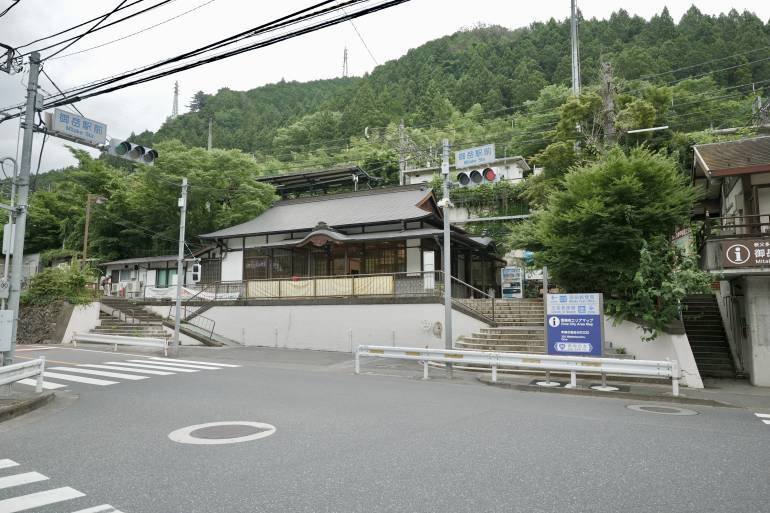
Step 1: Train
Take the Chūō Line Rapid train to Ōme Station (around 80 minutes), then change to the local Ōme Line bound for Okutama and get off at Mitake Station (another 15 minutes). It costs ¥950 in all.
Step 2: Bus
To head to the mountain, follow the signs to the bus stop right across the station, which will take you to the cable car. The bus schedule is timed with the train schedule, which means wait times are usually short. The ride is only around 10 minutes and costs ¥340.
Step 3: Cable car
At the cable-car station, you can either get your ticket from one of the machines or simply swipe your Pasmo or Suica card at the gate before you get on.
The 10-minute cable-car ride offers great views and has some automated guidance in English, making it quite the scenic ride. Return tickets are ¥1,200 for adults and ¥600 for children. If you are staying overnight, return tickets will cover you for the next day.
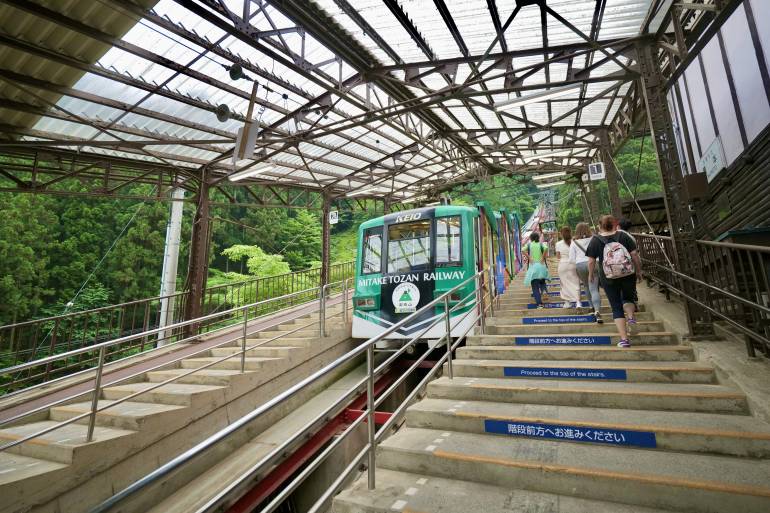
Alternatively, you can hike up Mt. Mitake from the bottom of the cable car, but this portion isn’t very scenic and would take quite a while, so we recommend taking the cable car and starting your hike from the observatory where it will spit you out.
What to do on Mount Mitake
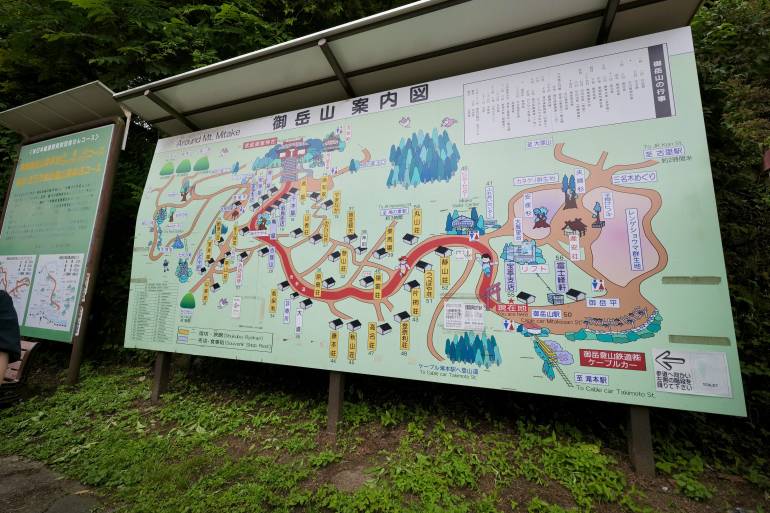
Everything starts when you exit the cable car at the top. There are clear signs either guiding you left towards the main Mount Mitake town and shrine, or to some observation points to the right.
Mount Mitake Observatory
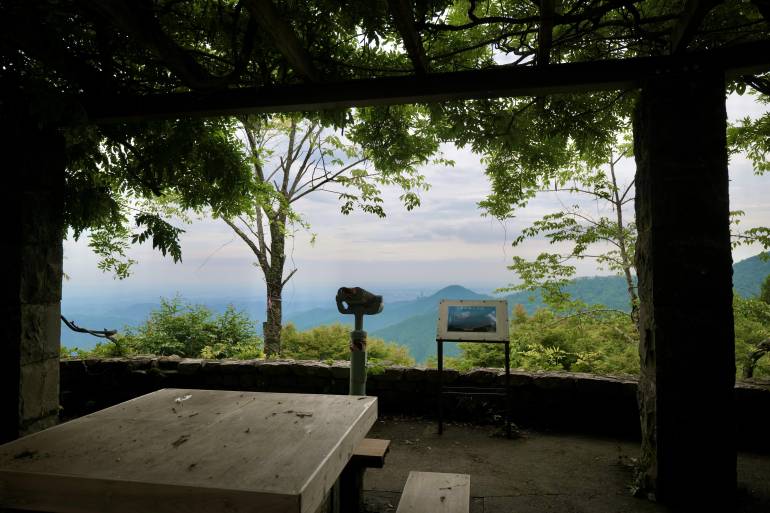
There are several spots to see great views of Tokyo from Mt. Mitake, but the observation point right next to the cable car is the easiest to access. You can even spot Tokyo Skytree in the distance.
If you want to venture farther up, there is a chairlift nearby costing ¥190 (round trip) — you can also walk. From the top, you have an even more elevated view and a chance to snap a photo on the Mitake Musasabi Swing (if you pay ¥500).
Escape the heat in Tokyo! (7 FREE indoor spaces + getaway ideas)
Looking for refreshing places to rest, besides your hotel? Explore these cool oases around Tokyo and Shibuya. Plus – lush, green areas like Kusatsu and Kamikochi are easily accessible by bus. …
The swing is open on weekends and national holidays, though it may be closed depending on the weather and season. Note that the chairlift may be closed sometimes too.
A short walk away from the swing is Ubuyasu Shrine, which is said to promote safe childbirth and has several sacred trees.
Shinto Shrine Village and shops
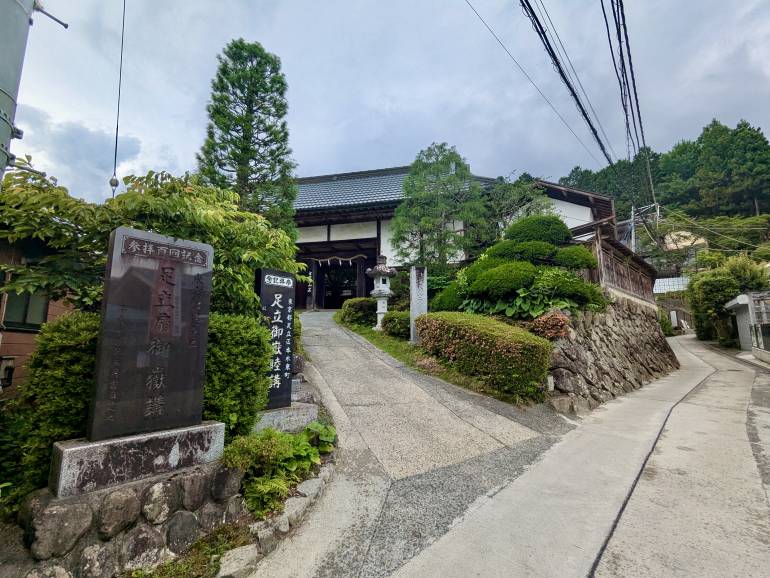
The main route leading up to Musashi Mitake Shrine takes you past many shukubo, shrine lodgings that were once used for traveling pilgrims hiking the mountain. They now offer casual visitors traditional stays and experiences like meditation and takigyo (cleansing your mind under a waterfall). More on how to book one below.
Besides the Shinto lodgings, the area has a modest selection of souvenir shops and restaurants (usually serving typical Japanese dishes like soba, udon, and tempura) on the main shopping street. Flying squirrel motifs are a common occurrence as the area is known for the nocturnal critters, including a giant species called musasabi.
Musashi Mitake Shrine
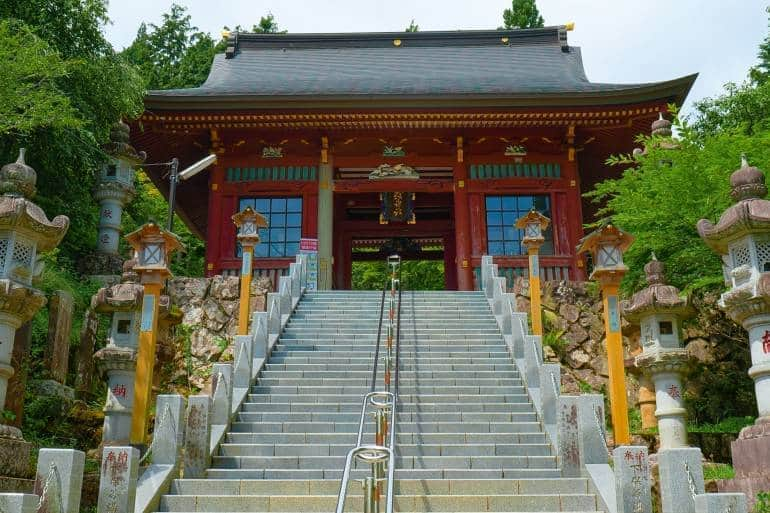
Mt. Mitake is home to Musashi Mitake Shrine, and the surrounding village is made up of over a dozen Shinto priest families that have been caring for the shrine for centuries.
Travel Japan with Real Unlimited Data — Now 20% Off with Code CHEAPO20
Unlimited 5G data across Japan with instant eSIM setup. Connect on KDDI AU, one of Japan’s top networks. Just ¥2,380 for 7 days — now 20% OFF with code CHEAPO20!
The shrine itself towers over the village, so you must climb up more than 300 steps and a few steep hills from the cable car station before you’re rewarded with striking views of Tokyo and the surrounding mountains. It should take around 30 to 40 minutes.
Musashi Mitake Shrine is said to have been founded around 2,000 years ago and enshrines many gods. The shrine’s buildings face east, where old Edo (Tokyo) is, to provide spiritual protection.
The Treasure Hall next to the shrine costs ¥500 to enter and often holds temporary exhibitions, as well as National Treasures and Important Cultural Properties like ancient samurai armor and swords.
Interesting fact: The shrine is popular with dog owners as it enshrines the wolf god Oinu-sama. So don’t be surprised if you see a bunch of canines on the same cable car as you.
Events on Mount Mitake
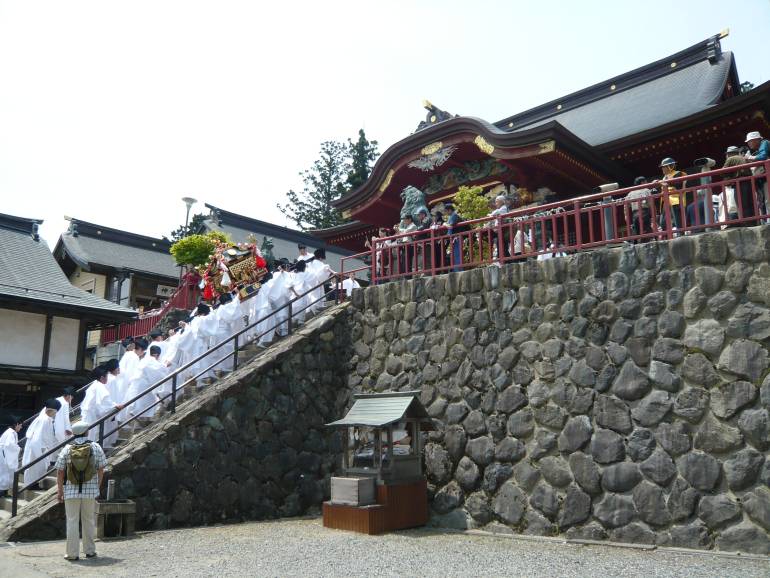
Musashi Mitake Shrine hosts many festivals and events throughout the year. Some require a stay overnight on the mountain. As you may expect, they have ceremonies on New Year’s Day (the first sunrise) and Setsubun, but these are some other highlights:
- Sunrise Festival on April 29 each year: A portable shrine is paraded through the streets and up the steps of the shrine, guarded by ancient warriors and children.
- Daidai Kagura Dance from June to November at 8 p.m., plus more dates: A 200-year-old tradition where men don masks and elaborate garb and dance for the gods. Check the shrine’s news page for details.
- Yabusame (horseback archery) on September 29 at dusk each year: This is not about competition (compared to other famous Yabusame festivals) but is instead an atmospheric religious ritual set in the dark with bonfires.
How to hike Mt. Mitake: One of the best hikes close to Tokyo
If you are looking to escape Tokyo for some nature with an added spiritual touch, make Mt. Mitake your go-to hike. While a little farther out than the uber-popular (and equally crowded) Mt. Takao, Mt. Mitake offers more scenic hiking courses of unspoiled nature that make you forget that you are, in fact, still in Tokyo.
The view of Mt. Fuji from a nearby mountain peak is an added bonus after taking in the beautiful forest and waterfalls.
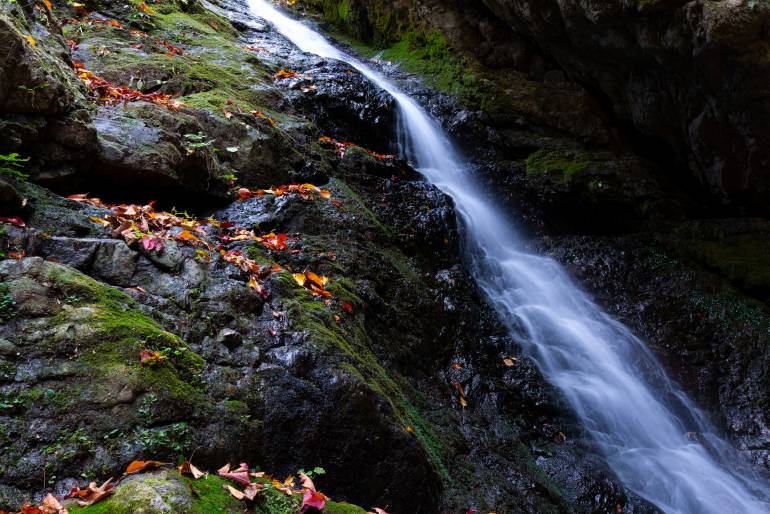
From the bottom of the shrine, several hiking trails start. All are signposted well, so no need to worry about getting lost. Grab one of the detailed maps (in English) from the cable-car station, the visitor center, or your lodging before you head out.
If you are returning on the same day, make sure you do not miss the last cable car back down; check the schedule before you take off for your hike, as it might change by season.
Important: No matter if you are returning home on the same day or staying overnight, do not be on the trails beyond sunset. Rangers might actually come by and ask you to turn around, as it is easy to get lost after dark.
Rock Garden Trail
In our opinion, the most beautiful hike is the Rock Garden Trail, or the Mount Mitake Loop Course. The hike is easy and leads you through a narrow, forested valley with a stream, moss-covered stones, and a sacred waterfall (Ayahiro Falls) at the end. It is a leisurely 3-hour round-trip trek from the cable-car station.
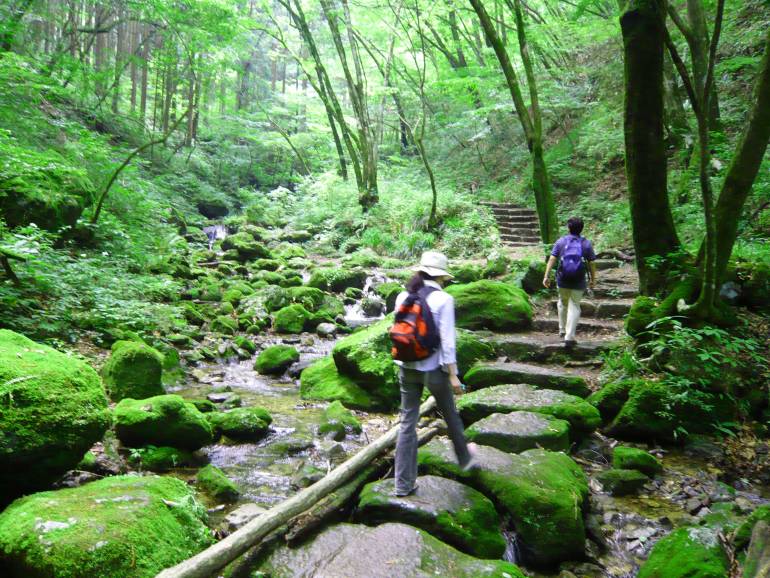
Pro tip: Here’s where you can find hiking gear in Tokyo.
Mt. Ōdake Trail
The Mt. Ōdake Trail will lead you through the mountains for several hours to the peak of Mt. Ōdake (1267 meters), from which you can view Mount Fuji on a clear day. It’s also known as Ōtake-san (or Kewpie Mountain on account of its whipped tip that resembles the company’s mascot).
The trail is about 4 to 5 hours round-trip, depending on conditions and how fast you walk. The first part of it is shared with the Rock Garden Trail. Some sections of the Mt. Ōdake Trail are quite steep and require a bit of rock climbing. Bring sturdy shoes if you choose this route.
For more trails in and around Tokyo, check out our hiking guide.
Where to stay on Mt. Mitake
Similar to the more famous Mt. Koya close to Kyoto, which is a popular destination for tourists wishing to spend a night in Buddhist temple lodging, Mitake-san offers the Shinto version of this experience: You can stay in a shukubo (traditional shrine or temple lodgings) overnight.

Shukubo are usually quite simple, but the home-cooked food, amazing night views of central Tokyo in the distance, and the restful sleep in the cool mountain air make it a worthwhile experience.
Rooms are traditional tatami, and the bathing facilities are usually shared. Unlike Buddhist cuisine, Shinto cuisine has fewer restrictions, and both meat and fish are served. Also, some of the lodgings offer takigyo, the Shinto practice of standing under a waterfall in meditation.
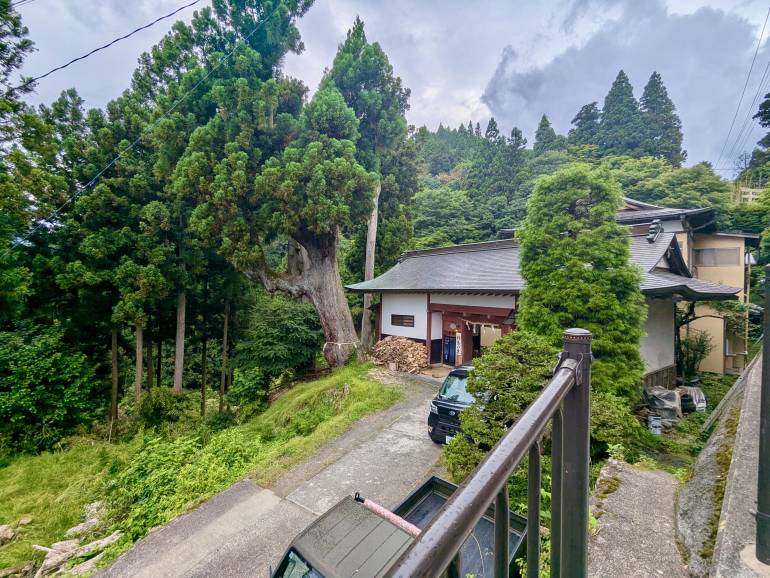
If you are staying overnight, your shukubo will expect you back by nightfall as dinner is usually served between 6 p.m. and 7 p.m. Also, you might want to hop into the bath before dinner to warm up if you went hiking, as Mt. Mitake is always several degrees Celsius cooler than central Tokyo due to its elevation.
Shukubo on Mount Mitake
Shukubo Komadori-Sanso (駒鳥山荘) offers affordable lodging and great views of the surrounding mountains. They welcome foreigners.

It is a family-run priest lodging that’s been open since 1776, and the father and son, who are both Shinto priests, speak a bit of English. They also offer waterfall rituals early in the morning for those who want the full Shinto experience. Also, ask them about their wildlife night walks to spot those giant flying squirrels we mentioned earlier. Rooms are around ¥14,000 per person, including home-cooked dinner and breakfast.
Mount Mitake FAQs
Common questions answered about Mount Mitake.
What is there to do near Mount Mitake?
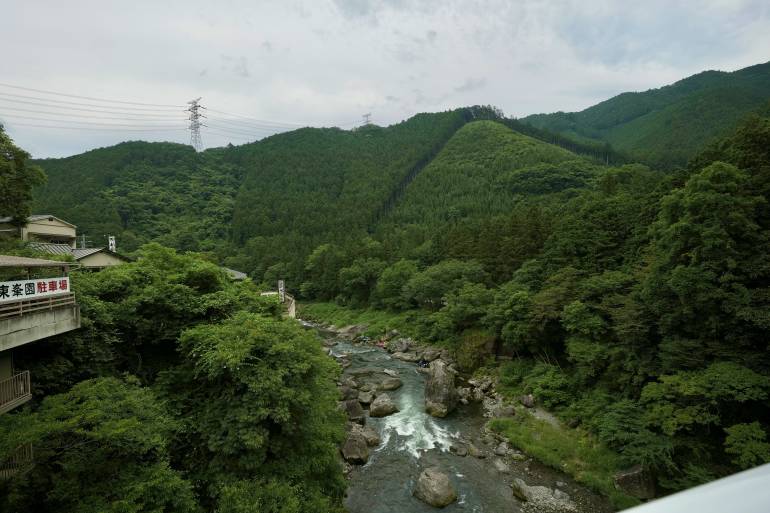
The beautiful, natural surroundings of Ōme and Mitake deserve more than a day trip to explore. Apart from venturing up the mountain, Mitake Gorge is only a 2-minute walk from Mitake Station and offers scenic views.
We also suggest visiting Okutama (a 20-minute train ride west from Mitake Station) and investigating trails, canyons, and camping. Just one train stop to the east is Sawai, where you can sip on sake and wolf down homemade tofu.
When is the best time to visit Mt. Mitake?
Due to its elevation of around 1000 meters above sea level, Mt. Mitake gets a lot colder than Tokyo, particularly at night. Dress accordingly and check the forecast. When we went in April, there was still snow on the peak, and gloves and hats were definitely good to have!
It is especially beautiful in autumn for the kōyō (autumn leaves), or in spring for the cherry blossoms, which bloom a few weeks later than in Tokyo due to the cooler climate. In summer, it is a great escape from the Tokyo heat. Lastly, in winter, some of the hiking trails might be closed due to snow and ice.
While we do our best to ensure it’s correct, information is subject to change. This article was originally published in February 2020. Last updated in August 2025, by Alex Ziminski.



:max_bytes(150000):strip_icc()/ParamountNetwork.180527-new-summer-shows-yellowstone-af238bf0cf8f4a9eab5bf80be0a99950.jpg?w=670&resize=670,650&ssl=1)
